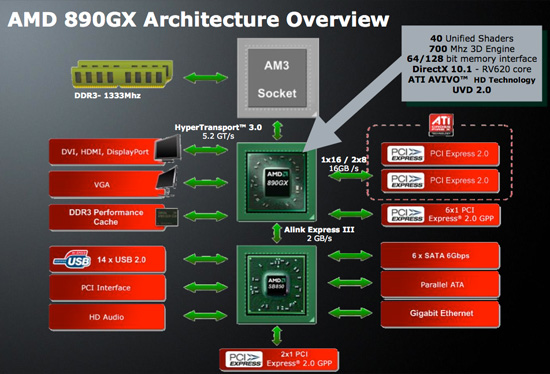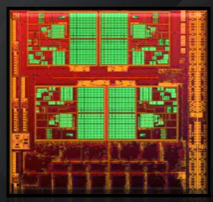AMD's 890GX Chipset - Same Graphics, Better South Bridge
by Anand Lal Shimpi on March 2, 2010 4:36 AM EST- Posted in
- CPUs
No news isn’t always good news. AMD has been purposefully vague on the graphics specifications of its 8-series chipsets. Today we know why. The AMD 890GX has the exact same graphics horsepower as the 790GX:
| AMD 890GX | AMD 790GX | AMD 785G | |
| CPU | AMD Socket-AM3 | AMD Socket-AM3/AM2+ | AMD Socket-AM3/AM2+ |
| Manufacturing Process | 55nm | 55nm | 55nm |
| PCI Express | 24 PCIe 2.0 lanes | 22 PCIe 2.0 lanes | 22 PCIe 2.0 lanes |
| Graphics | Radeon HD 4290 (DirectX 10.1) | Radeon HD 3300 (DirectX 10.0) | Radeon HD 4200 (DirectX 10.1) |
| Core Clock | 700MHz | 700MHz | 500MHz |
| Shader Processors | 8 (5-way) | 8 (5-way) | |
| Full H.264/VC-1/MPEG-2 HW Decode | Yes (UVD2) | Yes (UVD) | Yes (UVD2) |
| 8-channel LPCM | No | No | No |
| South Bridge | SB850 | SB750 | SB750 |
| USB | 14 USB 2.0 ports | 12 USB 2.0 ports | 12 USB 2.0 ports |
| SATA | 6 SATA 6Gbps ports | 6 SATA 3Gbps ports | 6 SATA 3Gbps ports |
In fact, it’s virtually the same graphics core as the 790GX and 785G built on the same 55nm process.

AMD 890GX North Bridge (left) vs. AMD 790GX North Bridge (right) - nothing has changed

SidePort memory on a motherboard
For those of you who aren’t familiar with AMD’s integrated graphics, it’s a 40 SP implementation of the RV6xx core running at 700MHz. The chipset supports optional SidePort memory. It’s an optional dedicated frame buffer that provides additional low latency bandwidth to the integrated graphics core. If your application demands more memory, the GPU can still use the CPU’s memory controller and system memory.

There haven’t been any improvements to the audio side of the chipset either. The 890GX still supports 2-channel LPCM or 5.1 Dolby Digital/DTS bitstreaming over HDMI. If you want more, AMD will happily sell you a Radeon HD 5450 to plug in to your new board.
AMD continues to offer full hardware H.264/MPEG-2/VC-1 video decode acceleration. The UVD2 engine responsible for the video acceleration remains unchanged from the 785G and 790GX.

Boards based on the 890GX will be well equipped with video outputs like this ASUS M4A89GTD Pro/USB3
Overall system performance remains unchanged. The 890GX performs no differently than the 790FX/GX chipsets:
| AMD 890GX | AMD 790GX | |
| x264 HD Encode - Average FPS | 26.6 fps | 26.6 fps |
| 7-zip Benchmark | 5962 MIPS | 5917 MIPS |
With nothing new on the integrated graphics front, the 890GX relies mostly on its new South Bridge, the SB850, to excite. AMD first doubled the bandwidth between its North and South Bridges. Then, it added a native 6Gbps SATA controller with 6 ports, a Gigabit Ethernet MAC and two PCIe 2.0 lanes. The SB850 doesn’t offer any native USB 3 support, so we’ll still see motherboard manufacturers rely on NEC’s external USB 3 controller. The new South Bridge does support two more USB 2.0 ports as well, bringing the total up to 14.
| AMD SB850 | AMD SB750 | |
| NB-SB Link | 2GB/s Each Direction | 1GB/s Each Direction |
| Additional PCIe | Two PCIe 2.0 x1 Lanes | None |
| USB | 14 USB 2.0 ports | 12 USB 2.0 ports |
| SATA | 6 SATA 6Gbps ports | 6 SATA 3Gbps ports |
| PATA | 2 Channels | 2 Channels |
| HD Audio Interface | Yes | Yes |
| Integrated Gigabit Ethernet MAC | Yes | No |
The first 890GX motherboards will be starting at $130. ASUS' M4A89GTD Pro will sell for $145, add another $10 if you want USB 3.0 support.

ASUS M4A89GTD Pro/USB3
I'd expect Gigabyte's pricing to be somewhere in line with that as well.

Gigabyte's GA-890GPA-UD3H
Ready for Integration
The 8-series of chipsets will be AMD’s last incarnation of traditional integrated graphics chipsets. Sometime next year we’ll get Llano, AMD’s first APU with a CPU and GPU on the same die.

AMD's Llano 32nm CPU/GPU due in 2011
At 55nm, the 890GX North Bridge is tiny. At 32nm the North Bridge would be about 1/3 the size. Now you can see why it makes sense to bring this on-die. The South Bridge is even smaller:

AMD SB750 (left) vs. AMD SB850 (right).
We’re not too far away from having nearly all of this technology integrated into the CPU.
The Test
| Motherboard: | ASUS M4A89GTD Pro/USB3 (AMD 890GX) Intel DH55TC (Intel H55) Gigabyte's GA-890GPA-UD3H (AMD 890GX) |
| Chipset Drivers: | Intel 9.1.1.1020 (Intel) AMD Catalyst 10.3 |
| Hard Disk: | Corsair P256 SSD |
| Memory: | Corsair DDR3-1333 2 x 2GB (7-7-7-20) |
| Video Card: | ATI Radeon HD 5450 |
| Video Drivers: | AMD Catalyst 10.3 |
| Desktop Resolution: | 1920 x 1200 |
| OS: | Windows Vista 7 64-bit |










65 Comments
View All Comments
Taft12 - Tuesday, March 2, 2010 - link
Fully agreed here, the lack of chipset competition has led to stagnation on both the AMD and Intel sides of the fence.Especially Intel, Anand admitted in the H55 coverage that Intel did not reduce chipset pricing even though removal of the IGP reduced their costs significantly. This horseshit would not occur if Nvidia and others weren't being blocked from creating their own offerings.
Penti - Tuesday, March 2, 2010 - link
They don't have licenses to produce chipsets any more. I fully disagree that it has led to stagnation though. Removing the memory controller on AMDs didn't lower the cost either. Both AMD and Intel finally has some enterprise (business) features such DASH and vpro too. Others simply couldn't keep up, nVidia killed ULI when they bought them, SiS and VIA has dropped out since a long time ago. Gaming components like nVidia 980a won't do a dent regardless of price.MadMan007 - Tuesday, March 2, 2010 - link
Hey Anand, thanks for including a modern low-end card for reference. I do have a request for what might be a useful article wrt IGPs for you. I'd like to know not how poor IGPs are compared to modern cards but rather to which *older* graphics card they are equivalent. Personally I haven't gotten many new games in a while and with Steam sales have been picking up some older ones too, there may be others in the same boat. Now when a game says it requires a much older card like a GF3 or Radeon 9000 or what have you I am pretty sure a modern IGP is better but once things start getting in to DX9 cards I'm not so sure. Would an IGP be equivalent to a 6600GT, or a Radeon 850?If you were to have someone do an article looking at this with older games that would be awesome and a great service to those who just play older games at this point. Finding IGP performance on older games is not easy.
nice123 - Tuesday, March 2, 2010 - link
Remember, GlobalFoundries is new. AMD are still using TSMC's 55nm process for this chipset. This is most probably because their 40nm process is absolutely crap. (as seen with the Radeon 5xxx yields and lack of Fermi)When AMD move to GlobalFoundries I think their hardware will pick up more, we won't have TSMC screwing up every single process they do.
Penti - Tuesday, March 2, 2010 - link
Still? What are you talking about, practically nobody uses the latest node for chipsets and many other none bleeding edge speed ASICs. At least they moved from 65nm. Intel chipsets are manufactured at 65nm.They won't move to GlobalFoundries for fabbing chipset/GPU logic till Liano APUs I guess they will design chipsets for GF then too.
Foxi - Tuesday, March 2, 2010 - link
AMD should ban Anand from testing theirs stuffs. It's a shame and pathetic as well. :sstrikeback03 - Tuesday, March 2, 2010 - link
lol, which part of this article offended you, fanboi?Penti - Tuesday, March 2, 2010 - link
How about the IOMMU (AMD-Vi) support in the SB850 chipset? It's supported right? I want to know if the chipset and bios combo has it working.semo - Tuesday, March 2, 2010 - link
Wondering about that too. I've seen articles here test for virtualization performance but only in the server space. Would be good to see more info about these sort of things around herePenti - Tuesday, March 2, 2010 - link
Yeah it works for SR5650-70-90/SP5100 server chipset, but it's not identical even if it's the chip it's based of. So I was wondering if there's really support in the silicon and perhaps more important if it's supported in the BIOS. Otherwise it's not really interesting for me. I will still only consider the Opteron platform for an AMD machine then and it makes choosing a Intel machine so much easier. But I guess not since AMD don't mention it. Might not matter for desktops, but it do for workstations and Intel desktops supports it (IOMMU). AMD-V is of course there but that's a whole other matter.